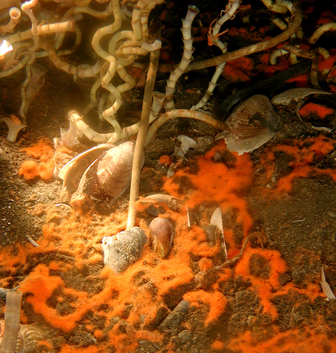Cold seeps

Picture has been licensed under a Creative Commons Attribution.
Original source: Tubeworm May Live Longer by Cycling Its Sulfur Downward. PLoS Biol 3/3/2005: e108. http://dx.doi.org/10.1371/journal.pbio.0030108
Author: (Photo: Ian MacDonald)
Original source: Tubeworm May Live Longer by Cycling Its Sulfur Downward. PLoS Biol 3/3/2005: e108. http://dx.doi.org/10.1371/journal.pbio.0030108
Author: (Photo: Ian MacDonald)
Facts about Cold seeps
deep sea, especially hydrothermal vents and cold seeps, has had a
dramatic influence on perception of life on the seafloor. These
chemically "hostile" environments nevertheless support unusually high
concentrations of organisms, forming oases of life on the seafloor.
Cold seeps were discovered in 1983 by Dr. Charles Paull in the Gulf of
Mexico at a depth of 3,200 meters (10,499 ft).
Only recently have cold seeps been recognized in the fossil record.
California's Panoche Hills has the largest set of fossil cold seeps
found in the world so far.
Cold seeps have recently been discovered fossilized in ancient rocks.
Inside these rounded carbonate lumps are the same kinds of tube worms
and bivalves seen in today's ocean. Many ancient shale beds surely
have more examples, previously overlooked, waiting to be found.
Cold Seeps in Monterey Bay
-
A.
methane released from cold seeps reach the atmosphere?? What do cold
seeps and hydrothermal vents have in common?? Answers to Other Common
QuestionsHow is Cold seeps's gallery? Image:cold seep
community.jpg|Tubeworms, soft corals and chemosynthetic mussels at a
seep located down on the Florida Escarpment.
Cold seeps are deep-sea environments, usually a few square meters in
size, where fluid is released through slow diffusion from the sea
floor. Mud volcanoes, which are active areas of fluid seepage, are
other extreme environments discovered in the 1990s.
Cold seeps are shallow areas on the
ocean floor where gases percolate through underlying rock and sediment
layers and emerge on the ocean bottom. The gases found in the seep are
methane and sulfur-rich gases and sediments releasing petroleum.
around cold seeps known in 2000.
There is a clear relationship between known hydrocarbon discoveries at
great depth in the Gulf slope and chemosynthetic communities,
hydrocarbon seepage, and authigenic minerals including carbonates at
the seafloor (Sassen et al., 1993a and b).
* Cold Seeps discovered 1984 at the base of the Florida Escarpment
at 3270 m depth; hypersaline with sulphide and methane seep out
onto the sea-floor; temperature is cold, but species composition
similar to hot
We have several projects studying cold seeps in the Gulf of Mexico. We
collaborate with Dr. Ian MacDonald (Florida State Univeristy), Dr.
Peter Girguis (Harvard Univeristy), Dr. Harry Roberts (Louisiana State
University), Dr. Chuck Fisher (Penn State University) and Drs.
Deep water cold seeps occur in both passive and active continental
margins, at depths ranging between 400 and 8000 m. The continental
margin is the slope that extends from the shelf edge (~200 m) to the
abyssal plains at 4000 - 6000 m of water-depth.
Cold seeps in the Aleutian subduction zone were found
after detecting a methane anomaly only 2 x the background in the
bottom water.
Cold seeps - Definition
=
Tubeworms, soft corals and chemosynthetic mussels at a seep located 3,000 metres down on the Florida Escarpment. Eelpouts, a Galatheid crab and an alvinocarid shrimp feed on mussels damaged during a sampling exercise.
